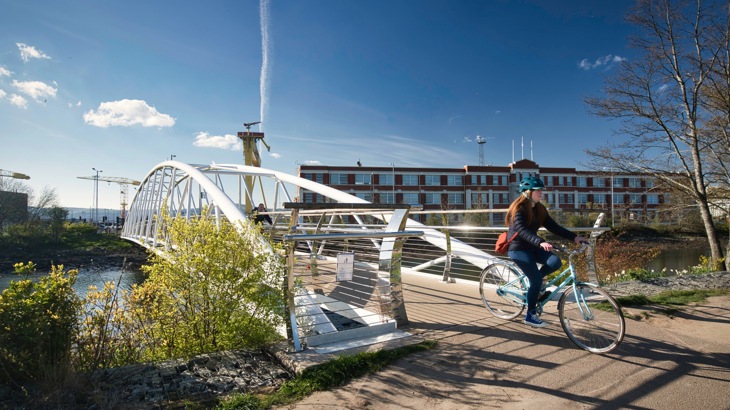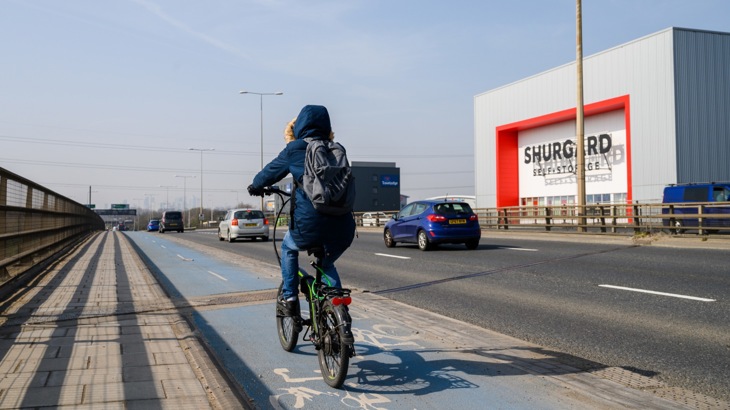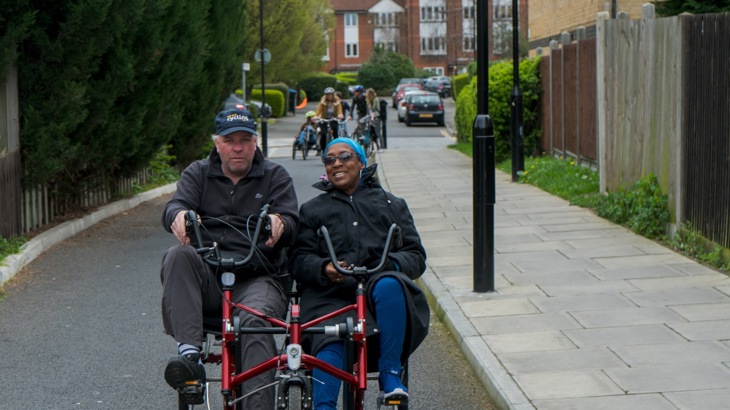Harry Tainton is a Senior Evaluation Officer in our Research and Monitoring Unit, the team which evaluates Sustrans’ impact and provides transparent and authoritative evidence on active travel. Here he discusses how we can avoid air pollution in our daily travel and make where we live more enjoyable to walk and cycle.

Credit: Brian Morrison
Air pollution from car fumes and brake and tyre wear contribute to between 28,000 and 36,000 premature deaths each year.
It’s a shocking statistic, and like many environmental problems, it’s something which feels tough to do anything about as an individual.
In fact, many of us regularly suffer from eco-anxiety, a fear or worry about the state of the climate.
But thankfully there are things we can all do to look after our health as well as improve the air around us.
How does air pollution work?
For most people living in the UK, road traffic emissions are the largest source of pollution affecting the air around us.
Typically, increased exposure means increased risk of health complications due to poor air quality.
You can think about it in a similar way to sun exposure: the hotter the day and the longer you spend in the sun, the more likely you are to get sunburnt.
The difference with air quality is that it is not an acute issue for everyone (although it is for some people).
It could take years for the effects of poor air quality to result in a health issue - a bit like smoking.
You might think 30 minutes each day in rush hour traffic is not too bad.
But the same commute or school run for five, 10 or 15 years? It can all add up.

Credit: photojB
How to reduce your exposure to air pollution
Before we get too gloomy though, let’s talk about what we can do to reduce our exposure.
The first change you can make is to avoid busy roads on your daily journeys.
This is because air pollution disperses in the atmosphere in the same way scent does from a candle.
The further you are from the candle, the weaker the smell (unless, of course, the wind is blowing in just the right direction).
For an idea of distance, national transport agency guidance suggests that only locations within 200 metres should be considered when doing an air quality assessment of a road.
Moving away from these sources, which include things like major roads with cars idling in traffic, will help you reduce your exposure.
The second step you can take is to swap the car for a bike as your main way of getting around.
This goes hand in hand with changing your routes, but there’s substantial evidence that even on busy roads, people on cycles take in the least air pollution.
Swapping car journeys for cycling will also give you all the mental and physical health benefits that being active brings.
Doing our bit to improve air quality
Alongside the positive impact on your health, walking, wheeling or cycling your daily journeys will help improve the air around us.
A study by Sustrans of 17 urban areas around the UK found that 1.99 billion journeys of three miles or less are driven each year.
If we chose instead to walk or cycle 80% of these journeys, then we could save approximately 660,000 tonnes of greenhouse gas emissions.
Those emissions in CO2 are the equivalent of over 800,000 people taking flights from London to New York.
Cutting greenhouse gas emissions by this much would help clean up the air around us and prevent the thousands of premature deaths and illnesses caused each year by air pollution.
If you needed any further incentive to stop driving in rush hour, this is it.

Routes like Quietway 1 in London provide a chance to keep away from the traffic of major routes. Credit: photojB
How to make the change
There are loads of resources available to help you plan your journeys and keep away from busy roads.
The National Cycle Network is made up of over 12,000 miles of routes for walking, wheeling and cycling, with more than 4,000 of those miles on traffic-free paths.
You can easily find a route based on your location, with mapping provided by OS.
In London, the Clean Air Route Finder, developed by the Mayor of London’s Air Quality Fund, allows residents to map out routes to walk or cycle based on the level of pollution along the way.
Your local council website may also have more information about walking and cycling routes in your area, as well as more on any cycling schemes that they might be running.
Cycle training can be useful for people of all experience levels to build up their confidence and make the switch to regular cycling.
If you’re completely new to it all, then you can check out our guide on cycling for beginners.
And if you need a bike to get you going, your employer may be able to support you with purchasing through the Cycle to Work Scheme.
The Sustrans shop is also stocked with a great range of cycling accessories, from helmets and pumps to maps and guides.
There’s everything you’ll need, and by buying with us, you’ll be supporting our work to make it easier for everyone to walk and cycle.
For tips on taking short journeys by foot, download the 'walking for clean air' toolkit from our partners, Global Action Plan, and support Clean Air Day.





